- ENTIRE Cooling-Off Period
- ENTIRE AUD Prices
- ENTIRE Change of Mind
- ENTIRE Industry Accredited
- ENTIRE On Ground Support
- ENTIRE Australian Owned























WWI Private Tour: Somme & Flanders (Tour code: 11918)
Ypres (Belgium)
Highlights
4 days with your own private Battlefields Guide
Freedom of Choice options - Behind the front lines.
Carefully selected memorials, cemeteries and museums in remembrance of the Somme & Flanders battles.
Hear the "Last Post" at the Menin Gate
Cancel booking
Are you sure you want to cancel this booking?
Book Now
Visit our Agent Portal for more info.
Make an enquiryThis package starts on specific days
of the week.
Overview
With this 4 day package, your own private Battlefields guide will take you on a journey in the footsteps of our Australian and New Zealand soldiers. Visit villages with names ingrained into Australian memory, such as Pozières, Fromelles and Villers-Brettoneux, visit well known sites such as Hill 60 and the trenches of Vimy Ridge, hear the haunting sounds of "The Last Post" being played at the Menin Gate in Ypres and an opportunity to see what life was like behind the front lines.

Inclusions

Our Freedom of Choice program offers flexibility, by allowing you to choose from different options on pre-selected days.
Our per person price includes one tour on each Freedom of Choice day, as follows:
- One "Freedom of Choice" tour on day 2
Expand the itinerary below for more details.
Please note, if more than one room is selected during the booking process, our team will contact you afterwards to discuss options.
Itinerary
Day 1 Arras Beaumont-Hamel Pozières Péronne Arras
Leaving Arras at 9.00am, you'll travel to the New Foundland Memorial Park at Beaumont-Hamel. Walk in the trenches and on the battlefield. We'll drive past Ulster Tower to the Thiepval Memorial and see the museum and visitors centre there. We continue on to stop at the "Moo Cow" Farm Memorial, with a visit to Pozières, the Memorial dedicated to the 1st Australian Division and the remains of the Gibraltar bunker, then on to the Windmill Memorial and later stand at the Lochnagar Crater.
We make our way to Péronne, where we will have lunch before visiting the Museum of the Great War in the old Citadelle. Visit the Memorial at Mont St Quentin before returning to Arras.
Overnight stay in Arras at the Mercure Arras Centre Gare in a standard room.
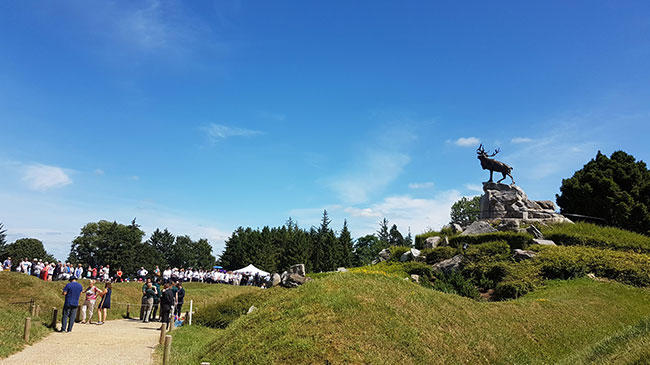
Day 2 Arras Villers-Bretonneux Le Hamel Vignacourt or Naours Arras
Leaving Arras at 9.00am, you will travel towards Villers-Bretonneux, which was akey village on the Western Front. See the Victoria School, viist the Australian National Memorial and the Sir John Monash Centre.
After lunch, the tour travels towards Le Hamel to see the battlefield where Sir John Monash wrote history.
Then, see what life was like behind the front lines. With our pre-selected Freedom of Choice options, you will have the opportunity to chose a visit to the Vignacourt 14-18 Interpretation Centre (closed Mondays) or the Underground City of Naours.
There will be a photo stop opportunity at the Chateau de Bertangles where Sir John Monash was knighted by King George V on 12 August, only a few days after his victory, and again in Doullens,see the town hall where the Unified Command was given to Général Foch on 26 March 2018. Entry is not included in this tour.
Note: The Sir John Monash Centre will be closed on 01 May 2024.
Overnight stay in Arras at the Mercure Arras Centre Gare in a standard room.
Freedom of Choice Options
-
The Underground City of Naours:
One of the most fascinating places to visit on the Western Front is Naours.
Many Alllied Soldiers visited the Underground City of Naours as tourists, a means of distraction for soldiers on leave or while they were recovering from injury behind the front lines. Many of them left their mark with graffiti on the walls of this underground city. In fact, there are over 3,000 instances of graffiti on the walls drawn by the WWI soldiers, 1,800 so far believed to be by Australians. The graffiti was forgotten and recently rediscovered in 2014.
Visit the Underground City* and the new Graffiti Museum.
*Note: Temperature in the underground city is approx. 9 degrees celcius. There is a large number of steps and this visit is not suitable for wheelchair users.
OR
-
The Vignacourt 14-18 Interpretive Centre:
A treasure trove of 4000 photo plates found in a farmhouse attic, forgotten for almost 100 years.
Vignacourt was an important military base located behind Allied Lines during the First World War.
During the war, local farmers, Louis and Antoinette Thullier, turned their farmhouse into a photo studio. Civillians and soldiers alike would come to have their photo taken. At the end of the war, the photo plates were stored in trunks in an attic and forgotten.... until 2011.
Now, the Vignacourt Interpretive Centre welcomes you to share the amazing story of this photo collection, which provides an insight into life in a village behind Allied Lines.
NOTE: This museum is closed on a Monday.
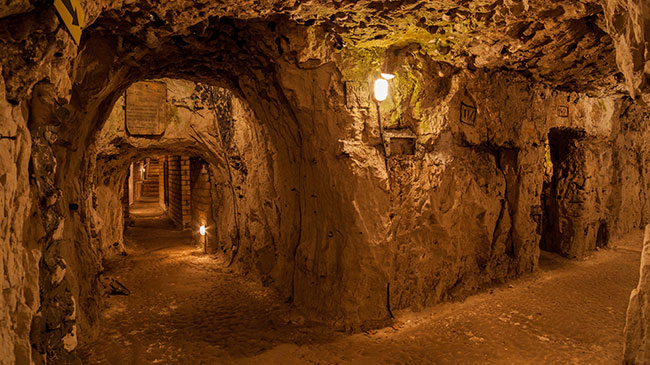
Day 3 Arras Vimy Ridge Bullecourt Ypres
At 9.00am, travel towards Vimy Ridge, stand near the Memorial where Canadian troops conquered the ridge, walk in the German and Allied trenches, go down in one of the tunnels dug by Welsh tunnellers.
You will stand at Notre Dame de Lorette, the largest French WW1 cemetery 42,000 burials, see the Basilica, the Lighthouse and the Ring of Remembrance bearing more than 580,000 names of soldiers from all nations.
After lunch, visit the Wellington Quarries where New Zealand and British troops stood hours before their surprise attack in Arras in April 1917. Then drive towards Bullecourt with a stop at Neuville St Vaast German Cemetery. In Bullecourt see the ”Slouch Hat Memorial”, the Standing Digger in the Memorial Park and visit the Jean & Denise Letaille Museum.
End your day in Ypres, stand in the main square and admire the Cloth Hall and the Cathedral. Enjoy some free time in Ypres and attend the Last Post at the Menin Gate.
Overnight stay in Ypres at the Ariane Hotel in a comfy room
Note: The Commonwealth War Graves Commission has started a 2 year restoration project of the Menin Gate. The Menin Gate Memorial will not be fully accessible to visitors during renovations. Scaffolding will cover the Memorial and the name panels entirely. The scaffold covering features one of the original pencil sketches of the Menin Gate by Sir Reginald Blomfield. The drawing is believed to date to 1921.
The daily Last Post service at 8pm will still take place but its location will be moved to an alternative location near the Menin Gate, usually on the bridge in front of the Menin Gate.

Day 4 Ypres Fromelles VC Corner Messines Ypres
Starting at 9.00am, travel towards Fromelles where Australian troops saw their first action in Europe. You will see the Museum of the Battle of Fromelles explaining how the remains of 250 British and Australian soldiers were found, exhumed and buried.
Visit the Australian Memorial Park, on the German front line, and stand near to the “Cobbers” statue and see the remains of some German bunkers. Walk to the only exclusively Australian Commonwealth War Grave Commission (CWGC) cemetery in France. VC Corner Cemetery is the resting place of 410 Australian soldiers. Also stop at Rue Pétillon Cemetery where many Australians killed in July 1916 were laid to rest.
Driving through Armentières towards Messines stop on the battlefield of June 1917 when Australians and New Zealanders captured the ridge prior to the Battle of Passchendaele. See the Messines Ridge Visitor Centre, the statue of a New Zealand soldier and the New Zealand Memorial.
After lunch, we drive to Hill 60 where the 1st Australian Tunneling Company detonated two mines on the 6 June 1917 at the opening of the Battle of Messines, stand near the Caterpillar Crater and the memorial dedicated to the 1st Australian Tunnelling Company.
This afternoon, you will also visit Polygon Wood to see the 5th Australian Division Memorial and the new “Brothers in Arms" Memorial, Tyne Cot Cemetery and Memorial as well as the Crest Farm Memorial. Visit Langemark German Cemetery and Essex Farm where John McRae wrote the famous poem “In Flanders Fields”.
The tour will end in Ypres where you may choose to extend your stay (additional cost apply).
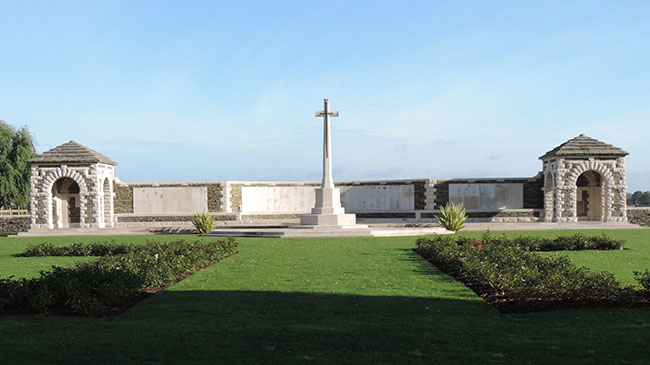
Accommodation
Ariane Hotel
Ypres
So quietly located and yet so close to the town centre. Nestled between the historic streets of Ypres, this family run 4-star hotel with 62 rooms, boasts every comfort to make you feel at home. The hotel rises modestly above the spacious gardens, creating a feeling of tranquillity and comfort.
The Menin Gate and the Cloth Hall are just a 5-10 mins walk away. Ariane’s excellent restaurant serves mostly Belgian delicacies using daily fresh seasonal products is popular with locals and guests alike.
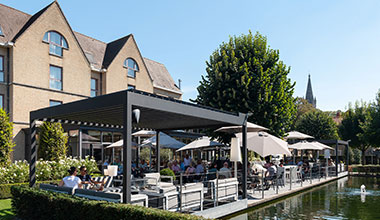
Mercure Arras Centre Gare Hotel
Arras
Ideally situated in the city centre, opposite the TGV station and in walking distance to the main squares. Enjoy the comfortable rooms and spacious living area at the Mercure Arras! Completely renovated, the hotel has a fun and chic setting. Different room types are available, whether you are traveling solo or with family. Have an enjoyable time at the bar and restaurant. Sporty guests can work at the fitness centre.
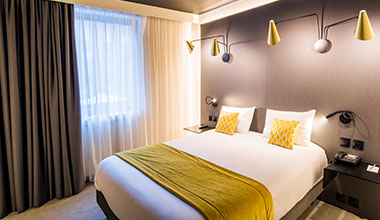
Additional information
On request this package may start in Amiens. Please contact us for a quote.
If you would like to incorporate a visit to a relative's grave, where it falls within the itinerary area, please advise details as early as possible and no later than 35 days prior to the package departure. If extra time is needed at a relative's grave, then the rest of the day's itinerary may need to be slightly altered.
For pre/post accommodation, please contact our Sales Team.
The order of visits in this package can be modified depending on availability.
Excluded
- International airfares and taxes
- Domestic airfares and taxes, unless otherwise specified in our holiday package
- Visa expenses, processing and issuance fees
- Meals other than as specified in our holiday package
- Travel Insurance or expenses of a personal nature (mini-bar, phone call, laundry, etc.),
- Tips or gratuities to guides, drivers, porters, hotel, restaurant or boat staff, etc.
- Or any other travel expense that has not been included in our holiday package
FAQs
Who are Entire Travel Group?
Welcome to Entire Travel Group. We offer exceptional travel experiences across our extensive range of Entire Holiday Packages, Entire Group Journeys, Entire Rail Journeys, and Entire Cruise Journeys. With our industry-leading Peace of Mind Booking Plan, you can Book Now with flexibility and confidence.
Entire Travel Group is celebrating over 50 years of passionately delivering unique and memorable travel experiences. We are an Australian, family-owned, award-winning business with a friendly team ready to match your expectations to the perfect holiday experience.
Entire Travel Group used to be known by the individual brands shown in the footer of the website. The company has not changed, but we have amalgamated under one brand - Entire Travel Group.
For more details please visit - About Us | Entire Travel Group
Is Entire Travel Group Australian owned and operated?
Entire Travel Group is proudly Australian family owned and operated and as it stands today represents 50 years of experience, progress, and evolution. We proudly support the community with our long-term commitment to many important charity organisations. We were awarded the best operator in our class at the most recent National Travel Industry Awards.
Is Entire Travel Group industry accredited?
Entire Travel Group is both ATAS and CATO Accredited. ATAS is actively administered by the Australian Travel Industry Association (ATIA). The Council of Australian Tour Operators (CATO) is the trade association representing the land supply sector of the Australian Travel Industry.
Does Entire Travel Group have industry awards?
Entire Travel Group was honoured at the 2023 National Travel Industry Awards with Most Oustanding Wholesaler - Product / Service.
As our team works tirelessly to deliver exceptional holiday experiences, it was exciting to have this acknowledged with the highest recognition. The award is also a testament to the quality of our partners around the globe, and we take this opportunity to thank them for their tremendous support of our customers.
Are the Entire Travel Group holiday packages exclusive?
In some cases, we are the sole representative in Australia for the overseas travel operator. In other circumstances the product developed has been exclusively built for Entire Travel Group and can’t be found elsewhere.
What’s unique about Entire Travel Group Holiday Packages?
- They are not group tours with set departures - they are pre-designed, purpose built, independent holiday packages full of unique and memorable experiences.
- Our holiday packages have been exclusively built for us in collaboration with our handpicked suppliers, who also offer full on-ground support for the clients.
- We are offering unique travel experiences which cannot be found elsewhere.
- Many packages include our “Freedom of Choice” options which allow you to tailor the holiday experience. Like a sommelier matching wine to a meal, we have used our experience to carefully select and offer the right experiences in each location.
- They include our Peace of Mind Booking Plan.
- A wide selection of our packages are compliant with the World Travel & Tourism Council (WTTC) Covid Safe Travels.
Our motto for Independent Holiday Packages is start your holiday when and with who you want!
Our Independent Holiday Packages are NOT group tours with set departure dates. Group Tours have specific set departure dates, and of course, you are travelling with unknown passengers in a coach. These tours are great for certain travellers and there are many reputable tour operators providing a wide range of options around the world.
At Entire Travel Group, our focus is Independent Holiday Packages. Available daily, they are pre-designed, purpose built, packaged itineraries full of memorable experiences delivered by our hand-picked local partners.
Our holidays suit every demographic, from couples to singles, to retirees to families and everyone else in between.
Why travel with Entire Travel Group?
Of Entire Travel Group's attributes, we have settled on "When Experience Matters" as the quality we believe adds the most value to our customers. We have the experience to ensure your itinerary makes the dream holiday possible. Our continually enhanced technology allows our team to provide a quality customer service experience, and our partnerships with outstanding operators ensure we are confident of the on-ground experience for our customers.
For more details please visit - About Us | Entire Travel Group
How does the Peace of Mind Booking Plan work?
Our Peace of Mind Booking Plan allows you to book with confidence in the new international travel environment. With low deposits, a cooling off period and a flexibility period where you can cancel and rebook later, we really do have you covered.
For more details please visit - Peace of Mind Booking Plan | Entire Travel Group
Is there a cooling-off period?
Look for packages with our Peace of Mind Booking Plan logo on the website.
- We understand that occasionally plans may change, so we give you the confidence to proceed with a cooling off period.
- You may cancel for any reason within 7 days, where you will receive a 100% refund of your $100 per person deposit.
For more details please visit - Peace of Mind Booking Plan | Entire Travel Group
What is Freedom of Choice?
At Entire Travel Group we understand that our customers have their own personal tastes and interests - so throughout our packages look for “Freedom of Choice” which gives you the ability to tailor your holiday from the various experiences offered on selected days. Like a sommelier matching wine to a meal, we have used our experience to carefully select and offer the right experiences in each location.
The Freedom of Choice options are included in the package price, and the price remains the same regardless of the choice you make on each day.
Our Freedom of Choice program offers flexibility, by allowing you to choose from different options on pre-selected days in the itinerary.
- Our per person price includes one tour on each Freedom of Choice day in the itinerary.
- The price of the package remains the same regardless of the choice you make on each day.
For more details please visit - Freedom of Choice | Entire Travel Group
What is Book Now?
Book Now offers you the ability to make a reservation on our website for Holiday Packages that include our Peace of Mind Booking Plan. But it’s not just a static offer – you have complete flexibility from travel dates, passenger numbers, single supplements, room upgrades, optional extras, flexible booking terms and more.
- Our team will contact our overseas suppliers and confirm all arrangements.
- A Confirmation from our reservation system will be sent in the coming days.
- The Booking Number on this confirmation supersedes the website reference.
What forms of payment can be used at Entire Travel Group?
- To confirm a booking using our on-line Book Now process, a credit card must be used to pay the refundable deposit.
- For additional payments on the booking, Entire Travel Group supports bank transfer, credit card, TravelPay B2B, PaymentGate.
- For further details please visit our Payments page.
How secure is the Entire Travel Group's on-line payment portal?
- Entire Travel Group have partnered with TravelPay to ensure secure on-line credit card payments.
- TravelPay is a level 1 PCI DSS compliant, which gives you peace of mind that your payment card data is in safe hands.
- Entire Travel Group does not store any credit card information.
For more details please visit - Security and Compliance - TravelPay
Can you book my international airfares?
On some Islands Holiday Packages (e.g. Fiji), it is practical to include flights, so where we have done this it is indicated by the plane icon.
However, on the majority of our Holiday Packages, we do not include international flights.
We found that many customers may prefer to:
- Travel on a specific airline of their choice
- Have the flexibility to book flights with Frequent Flyer points
- Select flight dates that may be different to our Holiday Package start/end dates
- Use a Travel Credit already held with the airline
- Use their travel agent for this service
We are able to assist with flights on any Holiday Package, so please just notify us during the Book Now process or contact our team.
Should I take travel insurance?
Travel insurance is strongly recommended. During the Book Now process please confirm you require assistance, and our team will be in contact with you.
What should I do before travelling?
Before you travel it is your responsibility to ensure you have the appropriate documentation including visas. If you are travelling on a passport other than Australian or New Zealand, you will require a permit to re-enter Australia. It is your responsibility as the traveller and/or travel booker to meet all government entry requirements.
For more information please visit - Before you travel | Entire Travel Group
How does a Travel Agent make a booking?
Please visit the Entire Travel Group's Agent Portal. We are here to support our industry partners with a range of informative updates, marketing collateral for campaigns and a reward & recognition program.
How do I start a Booking?
- On any page that has Book Now simply follow the booking process.
- You must select the Travel Agent tick box and provide correct details.
- To confirm a booking only the refundable deposit is required.
- An agency credit card must be used for this initial payment.
How do I contact Entire Travel Group?
For more information please visit - Contact us | Entire Travel Group
SOMEWHERE ELSE TO CONSIDER
When experience matters
Subscribe now for your chance to win
a $500 Travel Voucher
Be the first to hear about our new Holiday Packages